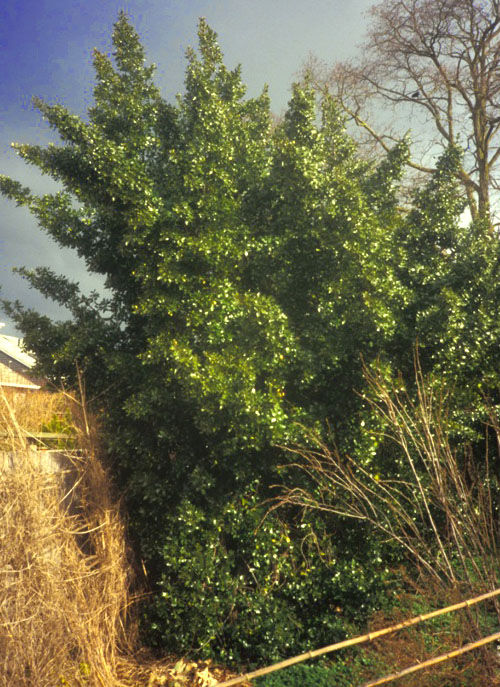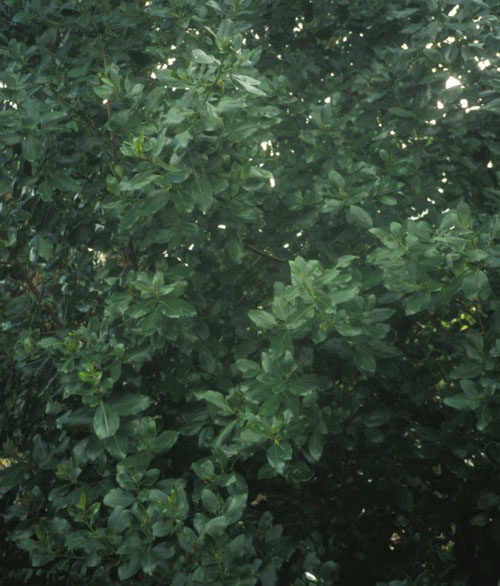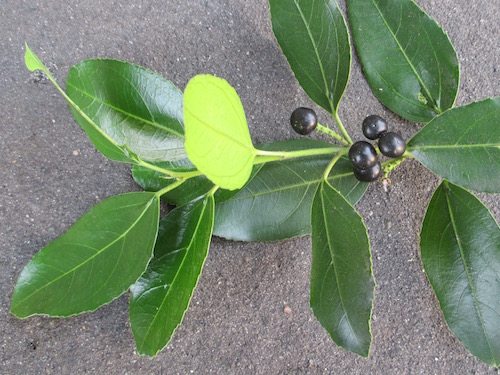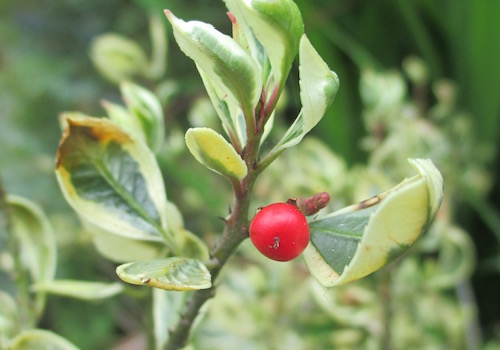| The genus Rhamnus consists of 125-160 species of widely distributed shrubs and trees, deciduous or evergreen, known as buckthorns in English. Rhamnos is the ancient Greek name of a thorny shrub (probably Rhamnus cathartica). Buckthorns are usually shrubby, and virtually none are remarkable for floral beauty or showy fruit. The very handsome foliage and excellent hardiness of some species has kept them from oblivion, yet still, their sudden disappearance would find few mourners. They are no more glamorous than musk oxen. Nonetheless, glamour is an overrated commodity best kept to small doses; we need quiet, too. |
| Nine Rhamnus species are native in North America, and two more naturalized weedily here. The unrelated sea buckthorn is Hippophäe rhamnoides. Two genera related to Rhamnus include Hovenia (Japanese raisin tree) and Ziziphus (Jujube). Some botanists prefer to break the genus Rhamnus into two genera: Frangula and Rhamnus. But historically most botanists have united these as subgenera under the Rhamnus lead --as I do here. |
| Alaternus is the ancient Latin name of Italian Buckthorn, adopted from the Greek Dioscorides, of unknown etymology. Italian Buckthorn is an evergreen shrub or slender small tree of bright, cheerful aspect. It is not thorny. The branches tend to soar upward, making the plant silhouette recall that of a tongue of flame upon a match end. It sometimes suckers from the roots. Its leaves measure as large as 3 and seven-eighths inches long by 1 and seven-eighths inches wide, are glossy rich green, and very finely toothed. They are short-stalked, alternate and hairless. Usually they have three main veins from their base. The flowers are inconspicuous, tiny and greenish, from March into early June; a tree can be male, female or bisexual. The flowers of females give rise to red, then black berries about a quarter of an inch to a third of an inch wide. Birds eat the berries. I have not noticed wild offspring in Seattle, but Italian buckthorn does grow weedily wild from cultivation in California, England, Australia and so on. So, planting fruitless specimens seems advisable. |
| Drought-tolerant, Italian buckthorn is best on well-drained soil; it likes calcium. It is hurt by severe freezes. Borers can bother it. Moist sites can cause it to become infected with fungal diseases such as Phytophthora. For the Seattle area, I suggest that it be grown in sites that are warm, dryish, well-drained and at least partly sunny. |
| Why should we plant Italian buckthorn? Despite its lack of floral beauty, it has advantages: evergreen and of a healthy color; usefully narrow form; tolerant of shearing; can be a shrub or a tree; and it is largely pest and disease free if planted in the right conditions. Broadleaf evergreen large shrub / small trees of similar texture and habit are apt to be more cold-tender, such as Dodonæa viscosa, or more thirsty, such as Eucryphia, or extremely hard to buy (and slow-growing, too), such as Phillyrea latifolia. Italian buckthorn is excellent, then, as an evergreen screen in between houses, or to hide unsightly views. |
| It grows fast. In 1995 I measured one 46.5 feet tall, its trunk only about 5.5 inches thick, in San Francisco, at Strybing Arboretum; but when I returned in March 2005 the tallest there was only 32.5 feet. A trunk about 4 feet around (15 inches diameter) was in San Diego (1994). In Seattle, about ten specimens are south of the Good Shepherd Center parking lot (4649 Sunnyside Ave N), the tallest 24.5 feet. The Green Lake PCC Natural Market (7504 Aurora Ave N) parking lot has some in the NE corner (with a Black Locust), the tallest about 17.5 feet. South Seattle Community College Arboretum has some, up to 22 feet tall. |
| Other than its role in the landscape, Italian buckthorn has been of minor value. Its wood has been used for turnery. Herbalists have tried the plant, too. From an unpublished book written by Gary Lockhart I quote the following: In 1856 Doctor Orioli published his results in lactation suppression using a tea made from the leaves. Six chopped leaves were added to a liter of boiling water and a cup of tea was drunk. A woman lost her infant son, and suffered greatly from breast pain in the following days. After a few days of drinking the tea, the discomfort left. (Journal de Medicine, Chirurgie et Pharmacie 76:426, 1883 "A Study of the Therapeutic Value of Rhamnus alaternus in the Enlargement of the Breast With Milk" Dr. Stocquart). |
And here are two cultivars of Italian buckthorn:
|
| R. Alaternus 'Argenteo-variegata' |
| = R. Alaternus 'Variegata' |
| = R. Alaternus 'Foliis Argenteis' |
Leaves narrow, edged creamy-white. More cold-tender than typical R. Alaternus. Smaller, but can reach small tree size. First described in 1770, it had been known much earlier. It was in California commerce by at least 1908. Long extremely rare, it has become more commonly sold in Seattle than the pure green typical form. It is pleasing, good for brightening a dark site. One was 13.5 feet tall in 2005, and is now 17 feet tall, south of the Seattle University's Sullivan Hall/School of Law building, east of the basalt sculpture.
|
| R. Alaternus John EdwardsTM |
Originated by the John Edwards nursery of East Palo Alto, California. Introduced in or before 1962 by the Saratoga Horticultural Foundation of California. A treelike clone, fruitless. Still in commerce.
|
Here are some photographs. . .
Back |

Italian buckthorn photo by ALJ
at the Green Lake PCC
|

Italian buckthorn photo by ALJ
showing foliage
|

Italian buckthorn berries photo by ALJ |

Variegated Italian buckthorn scan by ALJ
showing flower buds |

Variegated Italian buckthorn unripe berry photo by ALJ |

